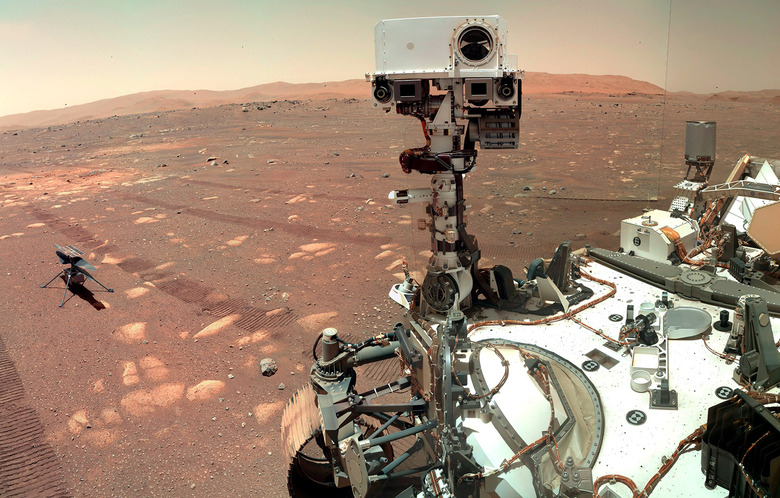A Robot Just Made Oxygen On Mars, Which Is A Huge Deal
Robots are a lot easier to send to other planets than humans are. For one, they don't complain nearly as much. On top of that, they don't need pesky things like food or breathable air. Of course, if we're ever going to send humans to Mars — as space agencies around the globe have pledged to do within the next few decades — we're going to have to figure out a way to either send those things along for the trip or make them once the missions arrive. NASA's Perseverance rover may have just taken a big step toward that goal by extracting oxygen from the Red Planet's toxic, carbon dioxide-soaked atmosphere.
Mars has a much thinner atmosphere than Earth, but gasses still cover the surface. Unfortunately, while Earth's atmosphere sports an oxygen concentration of just over 20%, the atmosphere of Mars is roughly 96% carbon dioxide. The oxygen level on the Red Planet is around 0.1%, which is obviously a big problem for us. However, if we can send hardware to Mars that can convert some of the carbon dioxide into oxygen — after all, CO2 is just O2 with an extra C — we could make our own breathable air without having to bring a bunch with us.
As the Perseverance rover sits nearby the testing grounds of the Ingenuity helicopter it's been working on an experiment that NASA calls MOXIE. MOXIE is short for Mars Oxygen In-Situ Resource Utilization Experiment. That's just a fancy name for a test to see if Perseverance could actually separate some oxygen from the atmosphere in a proof-of-concept experiment.
"This is a critical first step at converting carbon dioxide to oxygen on Mars," Jim Reuter, associate administrator of NASA's Space Technology Mission Directorate, said in a statement. "MOXIE has more work to do, but the results from this technology demonstration are full of promise as we move toward our goal of one day seeing humans on Mars. Oxygen isn't just the stuff we breathe. Rocket propellant depends on oxygen, and future explorers will depend on producing propellant on Mars to make the trip home."
Of course, the generation of oxygen using the technology NASA is playing with does generate a byproduct. The process removes one oxygen atom from CO2 and releases CO, or carbon monoxide, into the Martian atmosphere. Carbon monoxide can be deadly to humans as well, so there will have to be a delicate balancing act if we ever hope to produce oxygen on Mars on a large scale.
A future Mars where humans can walk on the surface and breath freely would require us to generate an atmosphere similar to that of Earth. It's been hotly debated whether or not such a thing would ever be possible, but as we inch toward crewed missions to Mars and see the results of experiments such as this, it sure does help us imagine it.
